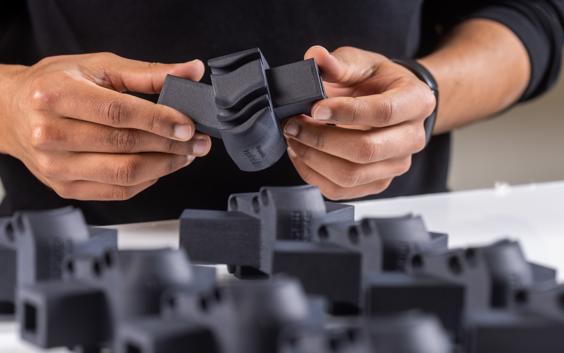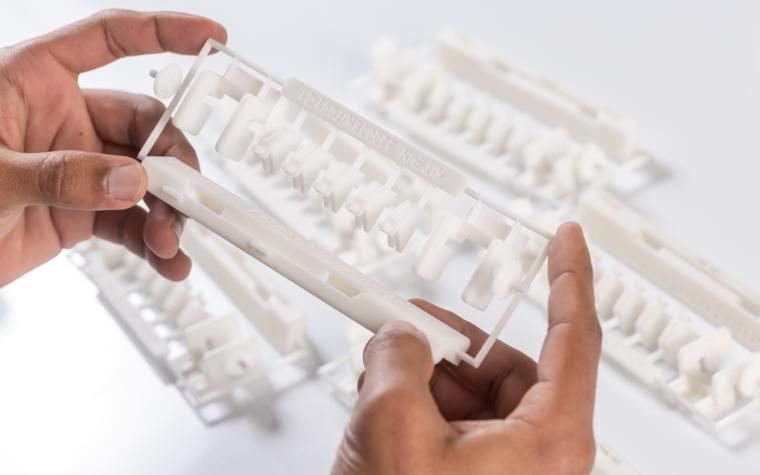EXPERT INSIGHT
Volume Production with AM: The 5 Questions to Ask Yourself About Your Next Project

Are you considering using additive manufacturing for series production? Evaluating your project with these five questions before you start can help ensure your parts are manufactured successfully.
What makes a successful additive manufacturing project? Like any other endeavor, it’s all about preparation — fail to prepare, prepare to fail, as the saying goes. When it comes to 3D printing parts, that exercise is all about reflection and taking the time to really understand what you want and need before moving forward.
So, how can you do that? One way is to look first at your project and ask yourself a series of questions — your answers may help identify a much more detailed list of requirements than you realized. Having this information from the beginning can help avoid any disappointment down the line, save you time and money, and lead to better results. To help you get started, we’ve split this evaluation into three main categories.
The product
The first set of questions relates to what you plan on printing. Quantity will always be the obvious question — how many do you plan on producing, now and in the future? But there’s more to it than that.
What factors do you need to consider to ensure repeatability?
Several factors, such as the application of a part, its inherent function, and tolerances, can create specific requirements for your project. It’s important to not only know this in advance — as is normally the case — but also if you plan to repeat your project in the future.
This is because it may not be possible to ensure conformity and guarantee that the minimum specifications will be identical without the correct controls in place. Importantly, the very design of your product may also need to change if you plan to produce in volume. What’s possible with a one-off print can differ greatly from something that needs to be produced in batches, particularly where tolerances are concerned.
In this case, there are two things to consider. Firstly, if your design file is ready, ask yourself what you designed it for — a one-off print or something that you’ll manufacture in small series — and if you’re prepared to change it if need be.
Which material properties are critical to your part(s)?
Whether related to a material, a finishing degree, or anything else, it’s important to identify which specifications are crucial to your project ahead of time. That way, you can request to be informed should anything change. For example, if your parts must adhere to a certain particle count to ensure surface cleanness and your chosen manufacturing partner changes its sandblasting process, they’d know to update you.
Cost, speed, and quality — what matters most?
Understandably, some lines cannot be ignored. Your timelines and bottom line, in particular. Where they fall on your list of priorities and how important you consider them compared to the other factors listed in this article can determine the options you have available to you. After all, there’s always a trade-off to consider: added complexity will likely result in longer lead times and higher costs.
In this sense, it’s important to be prepared to adjust your plans accordingly — reach out to a supplier with plenty of time, consider if you can simplify the project by altering your design, or look beyond the price to assess the value the extra services bring to your project.


The process
On top of the examples listed above, process control is something you will want to keep in mind — what assurances do you require when it’s time to bring your project to life? Is your project likely to require intervention from manufacturing experts? For example, perhaps your product needs to be assembled in a certified cleanroom or have an expert on hand to ensure your parts are nested in a specific orientation. Whatever the reason, if the answer to either question is yes, bear it in mind before proceeding.
How do your product requirements translate into quality management principles?
Quality is important to every customer, so don’t be afraid to ask your supplier for details of their certifications and qualifications to guarantee you get it. It could come in the form of a new product introduction (NPI) process or a quality management system with ISO 9001 certification, for instance. Ask yourself what guarantees your project requires, and evaluate each offering accordingly.
The documentation
What specific documentation do you require?
Documentation is often a crucial requirement, whether it’s for yourself or a customer — and exactly what you need varies according to your industry. For example, flight-ready parts often require EASA Part 21G certification, while others can get by with EN9100.
The specific documentation you need can also depend on other factors, such as your ability or willingness to certify the parts yourself — or simply be a matter of convenience. Ask your prospective partners what they can provide for you, as it can save you considerable time and take one more stressful task off your shoulders.
The 5 key questions
Understandably, this is a lot of information to take in — and it’s really just scratching the surface. By asking yourself the following questions at the start of the project, you can give yourself the best chance of success.
- What factors do you need to consider to ensure repeatability?
- Which material properties are critical to your part(s)?
- Cost, speed, and quality – what matters most?
- How do your product requirements translate into quality management principles?
- What specific documentation do you require?
Share on:
You might also like
Never miss a story like this. Get curated content delivered straight to your inbox.
